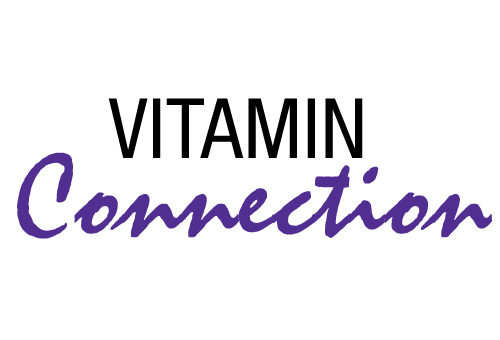Medical scientists are now realizing the importance of a particular form of vitamin K, the vitamin K2 form. Yes, the general medical community, by and large, still thinks of vitamin K solely in terms of its role in blood clotting, a very important role indeed, but there may be other equally—if not more important—roles that are only recently coming to light.
Let’s start at the beginning with vitamin K2’s role in bone health, move to its significant role in artery health and then touch upon vitamin K2’s ability to put inert proteins to work in the body for better health. Much of our increased understanding of the health benefits of vitamin K2 has come from Leon Schurgers, Ph.D., and his associates. Their breakthrough research has elucidated the role of vitamin K2 in preventing the calcification of arteries, which is a factor in most heart attacks.
Dr. Schurgers is a senior scientist in biochemistry at the Maastricht University in the Netherlands. As a senior scientist for the division on vitamin K research, Dr. Schurgers is part of the Cardiovascular Research Institute, the largest research institute of the University of Maastricht. Dr. Schurgers’s major occupation is leading the scientific part on vitamin K research and supervising technical engineers, post-docs and Ph.D. students. Dr. Schurgers is a member of the American Society of Bone and Mineral Research, the International Society on Thrombosis and Haemostasis as well as the American Heart Association. He has published over 50 research papers in the international scientific press.
Passwater: Dr. Schurgers, there have been additional advances in vitamin K2 research since your breakthrough work was published. I wanted to start our chat with your latest research, which is most interesting, but the media keeps reporting on the ill-conceived reports that this nutrient and that nutrient do not benefit bones. It is not the media’s fault in this case. In fact, so many scientists do not understand that health is the result of many nutrient interactions, which makes nutrients entirely different than drugs. True, scientists are taught to study one variable at a time, but they often fail to understand that this does not necessarily mean only one compound at a time, but one functioning unit at a time.
As an example, it is meaningless to study only 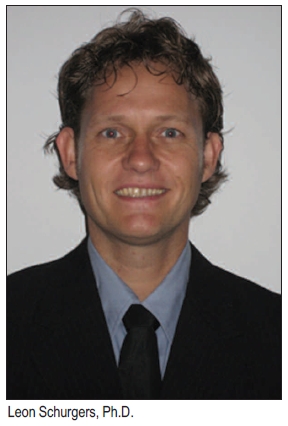 vitamin D or only calcium, when they must work in synergy. Calcium and vitamin D are only a part of the bone health story, however. Bone health studies have little meaning if they don’t include at least calcium, vitamin D and vitamin K. You can’t have healthy bones without being adequately nourished with vitamin K, silicon and other nutrients as well. So, let’s start with bone health.
vitamin D or only calcium, when they must work in synergy. Calcium and vitamin D are only a part of the bone health story, however. Bone health studies have little meaning if they don’t include at least calcium, vitamin D and vitamin K. You can’t have healthy bones without being adequately nourished with vitamin K, silicon and other nutrients as well. So, let’s start with bone health.
Dr. Schurgers, let’s address some common misconceptions that still linger with the general population before we discuss some of the new research. People tend to think of bones as being static structures. Why is it important that they understand that bone is live, dynamic tissue?
Schurgers: Thank you very much for giving me this second opportunity to discuss the most recent research illuminating the power of vitamin K2 to preserve health by affecting aging-related processes. Yes, quite a lot has transpired since our initial sit-down, and I welcome the opportunity to update WholeFoods readers.
It is indeed important to understand that bone is live, dynamic tissue. If something is alive and healthy, how can anything contained within it be static or not alive? The skeletal system is constantly in stages of revision and remodeling, a process known as “bone turnover.” It is very much a living, thriving physiological system, with properties way beyond its well-known protective and carrying function.
If bone were “static,” how would that explain the setting of a broken bone that actually heals after a certain amount of time? Orthopedic surgeons usually tell patients that a rib, arm, leg, finger or toe needs to be securely wrapped in order for the bones to “knit together.” This is a process of life, demonstrating that the bones are actively involved in reparation and self-preservation.
Additionally, bone is a factory of sorts; it produces osteocalcin, a hormone that helps increase insulin secretion and sensitivity and increases the population of insulin-producing cells. Osteocalcin also seems to protect against bone degradation and loss.
It is imperative that consumers understand that their bones are just like their other organs including the skin; the skeleton needs specific nourishment to remain healthy. This nourishment is a daily need, continually, starting as soon as possible. For moms, it means now—and it means right now for their infants and children, too. Yes, this goes for men as well, as men can and do suffer from osteoporotic fractures in later life. In fact, 50% of women over 50 years experience bone fractures, whereas some 25% of men over 50 years of age experience bone fractures. Please refer to Figure 1 for a comparison of normal, healthy and unhealthy bone tissues.
Passwater: People tend to think of “bone” as calcium. Bone is not chalk or calcium. The bone matrix consists of protein and mineral. The protein is synthesized first, and then the mineral is added. The vast majority of the organic matrix is collagen, which provides tensile strength. Then, the matrix is mineralized to provide compressive strength. Which nutrients are required to produce healthy bone and which nutrients become parts of bone structure?
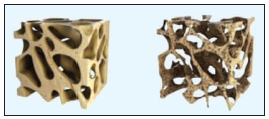
|
| Figure 1: Healthy bone structure compared to demineralized unhealthy bone structure. Bone is a living material comprised of a hard outer shell and spongy inner tissue structured to withstand the physical stress of bearing body mass. The entire skeleton is replaced approximately every seven years due to the remodeling action of osteoclasts (i.e., bone-resorbing cells) and osteoblasts (i.e., bone-forming cells). Osteoblasts produce osteocalcin. However, osteocalcin is inactive until activated by vitamin K. Vitamin K is needed for the activation of proteins (e.g., osteocalcin) involved in bone formation, which is why a diet low in vitamin K2 reduces bone strength and density. |
Schurgers: The primary bone tissue, osseous tissue, is composed mostly of calcium hydroxylapatite. You described it perfectly in our last interview: “Bone consists of a matrix of protein that hold the minerals together. Vitamin C is needed for collagen cross-linking. Copper, zinc, manganese and boron are needed as co-factors for the enzymes that act in the synthesis or posttranslational modification of constituents of bone matrix. Silicon is needed for collagen production and to act as a cross-linking agent to stabilize the glycosaminoglycan network. Vitamin D is needed to regulate calcium homeostasis, and to produce osteocalcin. However, even if you have more than enough calcium, vitamin D and osteocalcin in your blood, bone formation will be greatly impaired without adequate vitamin K to activate the osteocalcin so that it will be able to bind the calcium and put it into the bone tissues.”
Bone relies on calcium for its structure, function and health. Bone tissue also contains blood vessels, nerves and cells. Bone structure is secured by two types of cells: osteoblasts, which build bones, and osteoclasts, which remodel bones. Osteoblasts produce the protein osteocalcin, which must be activated by vitamin K to bind calcium to the bone’s mineral matrix, thereby strengthening and organizing the skeleton.
Passwater: What is the role of vitamin K2 in bone formation?
Schurgers: Overall, the unique side chain of isoprenoid units of vitamin K2—menaquinones—differ in length from one to 14 repeats, and they are all used by the enzyme g-glutamate carboxylase to activate a specific set of proteins, including proteins involved in blood coagulation, bone formation and the inhibition of soft tissue calcification. Please refer to Figure 2.
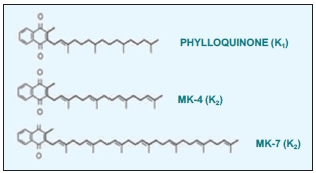
|
| Figure 2: Structural formulas for various forms of vitamin K. Different types of vitamin K vary in length and saturation (double versus single bonds) of the isoprenoid side chain. Vitamin K2/menaquinones are abbreviated as MK-n, where “n” denotes the number of isoprene repeats (C5H8). |
Vitamin K (K1 and K2) is essential in maintaining blood homeostasis and optimal bone and heart health through the role it plays in inducing calcium use by proteins. Vitamin K, particularly vitamin K2, is essential for calcium utilization, helping build strong bones and inhibit cardiovascular calcification.
What that means is that the menaquinones, specifically menaquinone-7 (that is vitamin K2), preserve both bone strength and density via activation of osteocalcin.
Passwater: So, the bone-forming and mineralization cells called osteoblasts produce osteocalcin, but osteocalcin is inactive until activated by vitamin K. As you mentioned in our previous chat, vitamin K achieves a process on the proteins called “carboxylation.” Carboxylation gives the proteins claws so they can hold onto calcium. Once the protein grabs onto calcium, it can be moved. Gamma-carboxylation is catalyzed by the vitamin K-dependent gamma-carboxylase. If there is not enough vitamin K2 in the blood, then some of the matrix Gla-protein will remain inactive and not able to do its job of putting calcium where it belongs.
Thanks for the background. Now, let’s get right to the point. Are there clinical studies that show that vitamin K2 produces healthier bones in real people?
S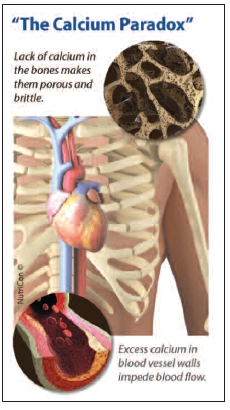 churgers: Absolutely. We are way beyond the in vitro stage, and there have been K2 (MK-7) studies in normal populations, such as apparently healthy post-menopausal women. We also concluded a study on a small population of health-compromised people undergoing dialysis.
churgers: Absolutely. We are way beyond the in vitro stage, and there have been K2 (MK-7) studies in normal populations, such as apparently healthy post-menopausal women. We also concluded a study on a small population of health-compromised people undergoing dialysis.
If there is a lack of vitamin K2 over a long period of time, then osteocalcin will not be activated and poor bone quality will result. Populations that consume enough vitamin K2 have stronger, healthier bones. The Western diet, however, does not contain sufficient vitamin K2, leaving many people vitamin K2 deficient, resulting in poor bone health.
Children, in particular, need more vitamin K2 since they have a much higher bone metabolism than adults. From the late 20s to mid-30s, peak bone mass is reached, after which bone mineral content slowly diminishes. Thus, the higher the peak bone mass attained at a younger age, the longer the bone mass can be preserved.
Passwater: That pretty much verifies that one should not take calcium supplements without ensuring that vitamin K2 levels are adequate. How about concern for bone breakdown due to vitamin K2 shortage releasing calcium into the bloodstream, which then can contribute to calcification of arteries?
Schurgers: The biggest concern with some individuals taking vitamin K2 supplements is they might over-activate blood coagulation, thereby causing unwanted clots. We recently demonstrated that this is absolutely not the case, and that extra vitamin K2 does not cause any problems with coagulation, thus, it’s absolutely safe for those not on oral anticoagulation treatment with vitamin K antagonists.
In terms of vitamin K deficiency, we and others have used undercarboxylated osteocalcin (ucOC) as a marker for vitamin K status of bone. There is consensus that high levels of ucOC—representing a vitamin K deficiency in bone—are correlated with high rates of bone loss. It is well known that bone loss is associated with ectopic calcification, in particular, vascular calcification.
Passwater: Okay. Dr. Schurgers, thanks for reviewing with us how vitamin K2 helps put and keep calcium in the bones. Let’s look at the other half of the equation of the “Calcium Paradox” in the next column and see how vitamin K2 helps keep unwanted calcium out of arteries. WF
Dr. Richard Passwater is the author of more than 45 books and 500 articles on nutrition. Dr. Passwater has been WholeFoods Magazine’s science editor and author of this column since 1984. More information is available on his Web site, www.drpasswater.com.
Published in WholeFoods Magazine, June 2014

